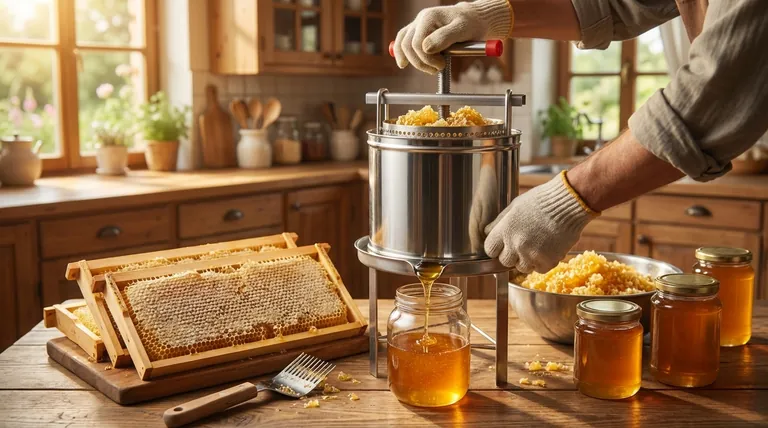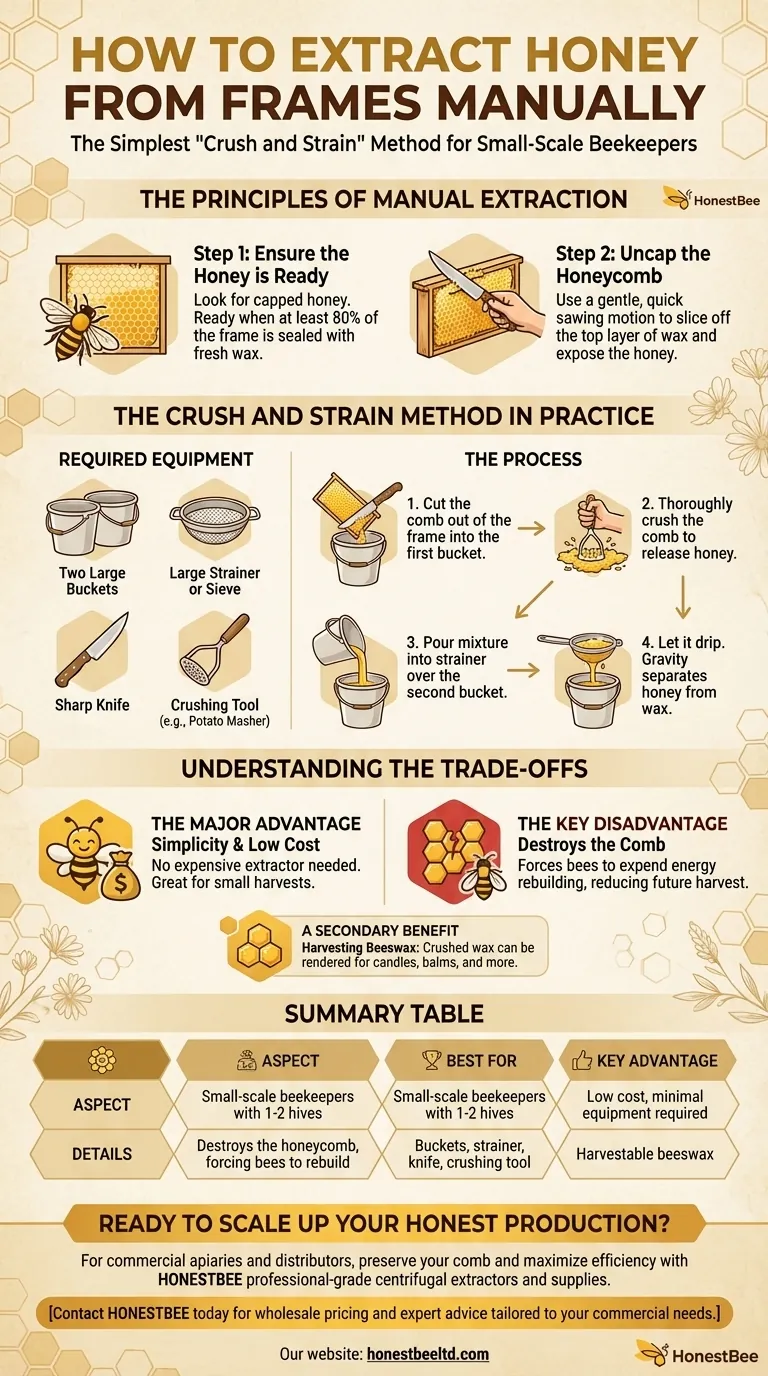The simplest manual method for extracting honey is known as "crush and strain." This technique involves cutting the entire honeycomb out of the frame, crushing it to break open the wax cells, and then straining the mixture to separate the pure honey from the beeswax. It is an effective, low-cost approach perfectly suited for beekeepers with only a few hives.
For the small-scale beekeeper, the decision to extract honey manually comes down to a fundamental trade-off: you gain simplicity and avoid the cost of an extractor, but you sacrifice the drawn-out comb, which forces your bees to expend energy rebuilding it.

The Principles of Manual Extraction
Before starting, the goal is to harvest ripe honey efficiently while minimizing stress on the colony. The entire process is guided by two key steps: preparing the frames and separating the honey from the wax.
Step 1: Ensure the Honey is Ready
Before you remove any frames, you must confirm the honey is "ripe." Honey that is not ripe has a high moisture content and can ferment in storage.
The bees will tell you when it's ready. Look for frames where the honeycomb cells are sealed with a fresh, white-to-yellowish wax coating. This is called "capped honey." A frame that is at least 80% capped is generally considered ready for harvest.
Step 2: Uncap the Honeycomb
Even with the crush and strain method, you must first break the wax cappings to release the honey.
You can use a simple, clean knife or a specialized uncapping fork or scratcher. If using a knife, use a gentle, quick sawing motion to slice off just the top layer of wax. The goal is to go "skin deep" and expose the honey within the cells without cutting deep into the comb.
The Crush and Strain Method in Practice
This method requires minimal specialized equipment and can be done easily in a clean kitchen environment.
Required Equipment
You only need a few basic items, most of which should be food-grade:
- Two large buckets
- A large strainer or sieve that can rest on top of one bucket
- A sharp knife for cutting the comb
- A tool for crushing, like a potato masher or simply your clean hands
The Process
- Cut the comb out of the wooden frame, letting it fall into your first bucket.
- Thoroughly crush the comb inside the bucket. Break up all the wax cells to ensure all the honey is released.
- Pour the honey and wax mixture into the strainer, which should be placed over the second, clean bucket.
- Let it drip. Gravity will do the work, but it can take several hours for the dense honey to filter through the strainer, leaving the beeswax behind.
Understanding the Trade-offs
The crush and strain method is effective, but it's important to understand its implications for your apiary.
The Major Advantage: Simplicity and Low Cost
This method's primary benefit is its accessibility. You do not need to purchase or store a centrifugal extractor, which can be expensive and bulky. It makes small-batch honey harvesting practical for any beginner.
The Key Disadvantage: Destroying the Comb
The most significant drawback is that this process destroys the drawn-out honeycomb. Bees expend a tremendous amount of energy and consume significant amounts of nectar to produce wax and build these intricate structures. By removing the comb, you force them to restart this process from scratch, which can reduce the potential size of your next honey harvest.
A Secondary Benefit: Harvesting Beeswax
The crushed wax left in the strainer is a valuable byproduct. Once the honey is drained, this beeswax can be rinsed with cold water, melted down, and filtered to be used for making candles, balms, or furniture polish.
Making the Right Choice for Your Goal
Ultimately, the best method depends on the scale and ambition of your beekeeping.
- If your primary focus is simplicity and a low-cost harvest for one or two hives: The crush and strain method is the most practical and logical choice.
- If your primary focus is maximizing long-term honey production across multiple hives: Investing in a centrifugal extractor is more efficient, as it preserves the comb and allows bees to focus on gathering nectar.
Choosing your extraction method is about aligning your equipment with your specific beekeeping philosophy and goals.
Summary Table:
| Aspect | Details |
|---|---|
| Best For | Small-scale beekeepers with 1-2 hives |
| Key Advantage | Low cost, minimal equipment required |
| Main Disadvantage | Destroys the honeycomb, forcing bees to rebuild |
| Primary Equipment | Buckets, strainer, knife, crushing tool |
| Byproduct | Harvestable beeswax |
Ready to scale up your honey production?
For commercial apiaries and beekeeping equipment distributors, manual extraction is not a sustainable long-term solution. Preserve your valuable drawn comb and maximize your harvest efficiency with professional-grade equipment from HONESTBEE.
We supply durable, high-capacity centrifugal extractors and other essential beekeeping supplies through our wholesale-focused operations. Let us help you build a more productive and profitable operation.
Contact HONESTBEE today for wholesale pricing and expert advice tailored to your commercial needs.
Visual Guide

Related Products
- Stainless Steel Manual Honey Press with Guard for Pressing Honey and Wax
- 10L Stainless Steel Electric Honey Press Machine
- Stainless Steel Honey Press Wax Press with Tank
- Electric Flatting and Embossing Machine with Tray for Beekeeping
- Professional Wide Blade Honey Scraper for Beekeeping and Honey Processing
People Also Ask
- What are the key features of a honey press? Maximize Yield with Durable, Efficient Extraction
- What was the overall experience with the honey press? Maximize Yield for Small-Scale Beekeeping
- What are the uses of honey in various industries? Unlock Its Functional Power in Food, Pharma & Cosmetics
- What happens to the wax after pressing in a honey press? A Guide to Maximizing Your Hive's Yield
- What are the multipurpose functionalities of a honey press? Versatile Harvesting for Beekeepers & Homesteaders



















